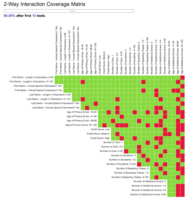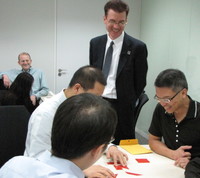Blog posts on process improvementPosts selected fromManagement Blog - Engineering Blog - Investing Blog and other blogs - 6 Questions to Ask Your Software Testers
 Making sure your software testing process is staying current with the best ideas in software testing is an important factor in creating great software solutions that your customers love. Often companies understand the need to stay current on software coding practices that are successful but fewer organizations pay attention to good practices in software testing. This often means there is a good deal to be gained by spending some time to examine and improve your software testing practices. continue reading: 6 Questions to Ask Your Software Testers - Autonomous Delivery Robots Launched in Europe and USA
 Robots developed by Starship Technologies are meant for delivering packages, groceries and food to consumers in a 2-3 mile radius. The robots can drive autonomously while being monitored by human operators in control centers. Introduced to European and American cities since the end of last year, the robots have already driven close to 5,000 miles and met over 400,000 people without a single accident. continue reading: Autonomous Delivery Robots Launched in Europe and USA - US Fish and Wildlife Service Plans to Use Drones to Drop Vaccine Treats to Save Ferrets
 To date, SPV has been applied by hand with people walking pre-defined transects and uniformly dropping single SPV baits every 9-10 meters to achieve a deposition rate of 50 SPV doses per acre. Depending on vegetation and terrain, a single person walking can treat 3-6 acres per hour. All terrain vehicles (ATVs) have been considered but have various problems.
If the equipment and expertise can be developed as proposed here, a single UAS operator could treat more than 60 acres per hour.
If the equipment can be developed to deposit 3 SPV doses simultaneously every second, as they envision is possible, some 200 acres per hour could be treated by a single operator. continue reading: US Fish and Wildlife Service Plans to Use Drones to Drop Vaccine Treats to Save Ferrets - Minimize Total Cost
Another common way of explaining this point is to discuss the problems created when organizations have created management systems that encourage decisions based on what is best for parts of the organizations. So when each department is appraised on whether they cut their costs each will seek to do so, no matter how much that increases the costs for other departments. The problems of this are fairly obvious and it isn’t that those choosing to create systems that focus on improving the parts want to accept these consequences. continue reading: Minimize Total Cost - Applying Toyota Kata to Agile Retrospectives
Retrospectives are a good method to help improve but if there is no time to think about the issues raised and come up with experiments to improve and review of whether those experiments worked or not and why failure to improve is the expected result.
Creating a culture where it is expected that any improvement ideas are tested and evaluated is one of the most important changes on the path to a company that will be able to continually improve. continue reading: Applying Toyota Kata to Agile Retrospectives - Examine the Results of Your Testing Practices and Continually Improve Your Methods
The idea of delibrately examining your software development and testing practices will be familar to those using agile retrospectives. The power of continually improving the development practices used withing the organization is hard to appreciate but it is immense. The gains compound over time so the initial benefits are only a glimpse of what can be achieve by continuing to iterate and improve. continue reading: Examine the Results of Your Testing Practices and Continually Improve Your Methods - Seek to Improve How You Learn, Don’t Just Accept That You Can’t Do Better
 Learning about how people learn and remember is important to allow you to communite well. And most people seem to understand this. But they also seem to have no shame in not improving their performance in relation to these common weaknesses...
What I see is people spouting these statistics, not as a way of learning what they need to improve themselves but as a way of explaining that it is inevitable and they won’t do any better (or even bother to attempt to do so). It just isn’t true that you can’t do better. You can train yourself to learn more than most people when the material is presented in a less than perfect manner by learning how we commonly fail to learn and making efforts to do better yourself. continue reading: Seek to Improve How You Learn, Don’t Just Accept That You Can’t Do Better - How to Lead From Any Level In the Organization
From an interview with me:
2. Help people solve their problems.
Similar to helping other people grow their careers is the idea of helping other people to solve their problems. Again, this starts with a clear understanding of your sphere of influence. “It determines what strategies you can pursue, and building your sphere of influence should be part of your decision making process.”
What it comes down to is proving yourself in this way—and doing so consistently. “It isn’t some secret sauce. Prove yourself to be valuable and you will gain influence. Help people solve their problems. They will be inclined to listen to your ideas.”
continue reading: How to Lead From Any Level In the Organization - PBS Documentary: Improving Hospitals
This rare good news documentary reports on a surprising solution to escalating costs, unnecessary deaths and waste in America’s hospitals. Doctors and nurses tell how they did their best, working overtime, while hospital conditions worsened. They were delighted to learn a new way to improve patient care dramatically and reduce unnecessary deaths, suffering, errors, infections and costs without additional resources or government regulations. continue reading: PBS Documentary: Improving Hospitals - Burning Toast: American Health System Style
 Democrats and Republicans have created a health care system in the USA over the last 40 years that “burns toast” at an alarming rate. As the symptoms of their health care system are displayed they call in people to blame for burning toast.
Their participation in the “you burn, I’ll scrape” system is even worse than the normal burning then scraping process. They create a bad system over decades and ignore the burnt toast just telling people to put up with it. And when some burnt toast can’t be ignored any longer they then blame individuals for each piece of burnt toast.
They demand that those they bring before them to blame, scrape off the burnt toast. And they act shocked that the "toaster" burns toast. It is the same "toaster" they designed and maintain at the behest of those benefiting from burnt toast and of course it burns toast (those results are the natural outcome of the system they designed and maintain). continue reading: Burning Toast: American Health System Style - Add Constraints to Processes Carefully
Frequently I see unnecessary constraints creating the edge case excuse. By burdening your process with unnecessary constraints you create edge cases that fail and then use the excuse that each of the edge cases is rare and therefore you can’t justify the expense of fixing them.
But if you designed the process sensibly in the first place the edge case never would have failed and you wouldn’t need special work arounds for such “edge cases.” A simple example of this is unnecessarily complex web page code that fails if to submit a button without javascript. Yes, a small number of users won’t have enabled all javascript to run (today anyway) so it is an “edge case” to deal with if you don’t have the form work without javascript. But there is no decent reason to have it fail in most cases. continue reading: Add Constraints to Processes Carefully - Continually Improving Using a Focus on Delighting Customers
 A deep appreciation for the long term needs of your customers and potential customers should guide where in the system to continually improve. And my belief on how to continual improve is to create and continually improving management system with principles of experimentation (with the necessary understanding of what conclusion can be drawn from results and what cannot), an understanding of the organization as a system and respect for people as principles to be guided by to achieve continual improvement.
Quality practices of experimentation directed at continually improving management practices and internal processes need to be completely integrated with the efforts to continual improve customer delight. Those efforts should be one process and therefore they automatically grow together.
The success of improvements should be evaluated at the system level (outcome measures not merely efficiency measures). In process measures are useful in adding evaluating improvement and monitoring processes but the end result for the overall system must always remain the primary concern. continue reading: Continually Improving Using a Focus on Delighting Customers - Unpacking the Components of Hard Work to Design Better Work Conditions
 “Hard work” is often code for “work I despise doing.” If you create a system where people take pride and joy in their work the same time spent working is not nearly as “hard.” If they are proud of what they accomplish a difficult task is often rewarding, and not seen as working “harder.” As is so often the case “hard work” is really packing together numerous ideas in one phrase.
- long hours
- difficult tasks (physically, emotionally or intellectually)
- unrewarding work
- unpleasant tasks
- inflexible work (It is a “hard job” if it prevents you from for example, seeing your child’s basketball game. If you were able to see the game and finish up 2 hours of work after they went to bed that is less hard.)
continue reading: Unpacking the Components of Hard Work to Design Better Work Conditions - Looking Back at "Some Notes on Management in a Hospital" by W. Edwards Deming
The head nurse returned to say that the nurse that was to give the infusion had recorded the infusion as given. It is possible that she recorded it in advance, with the intention to give it, and did not correct the record. Is this the regular procedure, to record intentions? Who would know? An unsuspecting physician, looking at the record for his patient, would assume that the infusion had been given, and could draw wrong inferences about how the patient had been doing on the drug. In my case, as it turned out, no harm. But how would he know? A nurse, or a physician, has a right to suppose that the medication was delivered as ordered and as recorded.
What is the purpose of the record? To inform the physician about intentions, or to tell him what happened?
It is even more difficult than usual to avoid blaming people when you are being forced to suffer. But even in this situation Dr. Deming understood the problems were a natural result of poor processes not of failures by individuals to do their best. continue reading: Looking Back at "Some Notes on Management in a Hospital" by W. Edwards Deming - Transforming the Management System of an Organization
I don’t think there are simple answers to the questions that take the form of “do this simple thing and you will have the results you wish to see.”
...
There are principles that can be fairly easily captured (respect people, improve using iterative experiments, use data to learn and test your understanding when possible but also realize that using data is not always possible…), but doing that does not offer a simple recipe laying out what steps to take. What should be implemented in your organization and what specific steps to take are not obvious, it requires applying the principles to your organization. And doing that also requires building the capability of your organization (including your people) to operate using those principles. continue reading: Transforming the Management System of an Organization
|